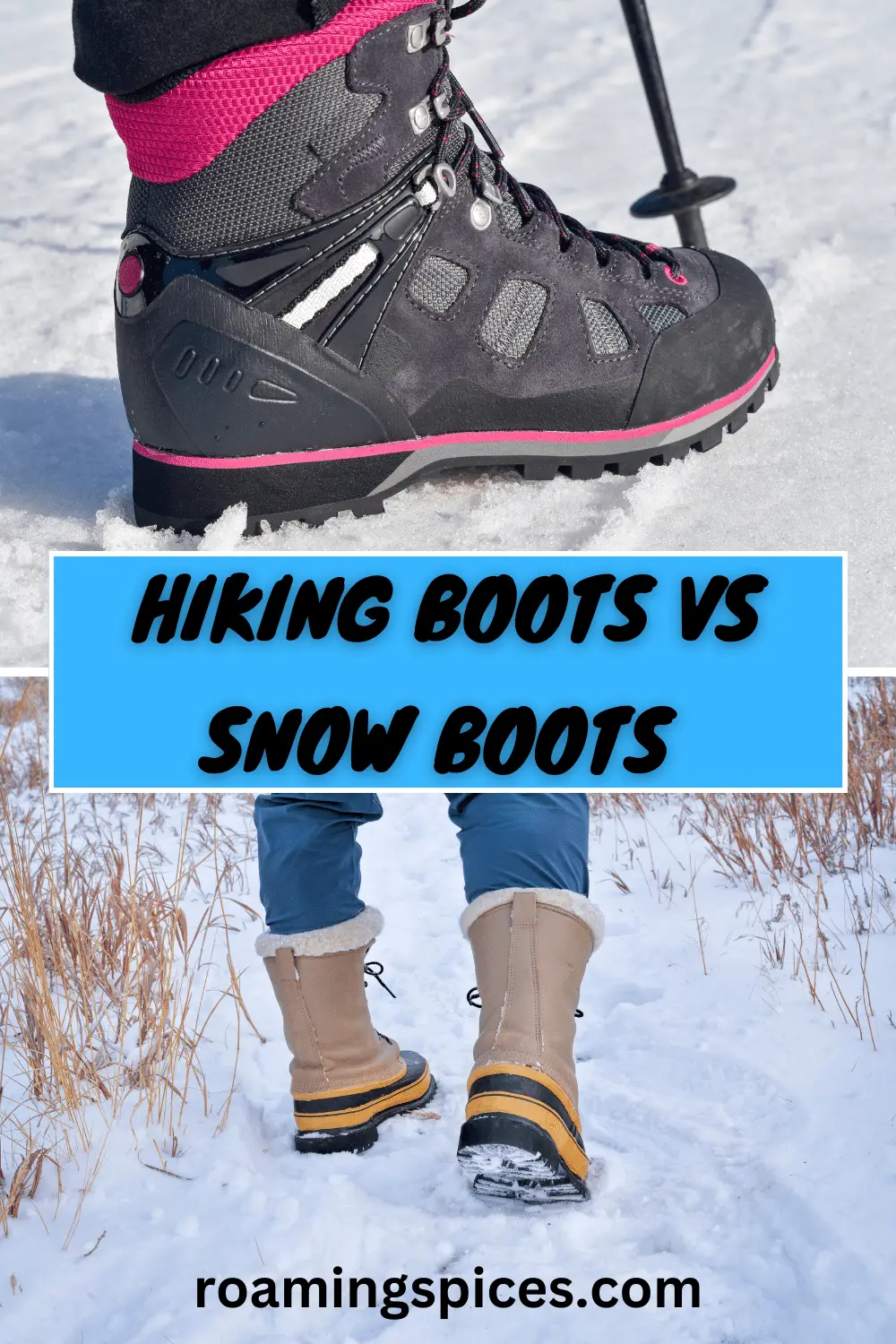
Hiking Tips
When it comes to hiking in the snow, the hiking boots vs snow boots choice is critical. Choosing the right type of boot can make all the difference in terms of comfort, traction, and protection, ensuring that you’re prepared for the specific terrain and weather conditions you’ll encounter on your adventures
Hiking Boots vs Snow Boots: Exploring the Key Differences
Choosing the proper footwear is paramount for outdoor activities in different seasons and terrains. Hiking and snow boots are designed to meet their respective environments’ challenges.
Understanding the critical differences between these two types of boots is essential for making an informed decision based on the intended use and conditions.
Hiking boots are crafted to withstand the demands of rugged trails and variable terrains. They feature durable construction, ankle support, and breathable materials to ensure comfort and stability during long hikes.
Hiking boots are designed to provide excellent traction, impact resistance, and flexibility, allowing hikers to navigate uneven surfaces confidently.
On the other hand, snow boots are engineered to tackle cold and snowy conditions. They prioritise insulation and waterproofing to keep feet warm and dry.
Snow boots often have higher shafts to provide additional protection from the elements and specialised outsoles with deep treads for enhanced grip on icy or slippery surfaces.
By exploring the unique features and materials used in hiking and snow boots, outdoor enthusiasts can choose the footwear that suits their specific needs, whether conquering challenging trails or braving snowy landscapes.
Traction
When comparing traction in hiking boots vs snow boots, both play essential roles in their respective environments. Hiking boots are designed to excel on rugged trails and uneven terrain.
They feature durable outsoles with deep lugs, providing excellent grip and traction on mud, rocks, and loose gravel. These boots offer stability and prevent slips, allowing hikers to navigate challenging landscapes confidently.
In contrast, snow boots are specifically engineered to tackle icy and snowy conditions. They prioritise traction on slippery surfaces, incorporating specialised rubber compounds and unique tread patterns.
Snow boots are designed to dig into the snow, providing superior grip and preventing accidents caused by slipping or sliding. Additionally, they often feature insulation to keep feet warm in cold temperatures.
While hiking and snow boots share some similarities in traction capabilities, their specific designs cater to different environments. Hiking boots prioritise versatility on rugged terrains, while snow boots focus on providing traction on icy surfaces.
Choosing the right boot for the intended activity and environment is crucial to ensure optimal safety and performance on the trails or in snowy conditions.
Weight
Weight is a significant factor when comparing hiking boots and snow boots. Hiking boots are typically designed to be lightweight and offer a balance between durability and agility.
The emphasis on weight reduction allows hikers to move swiftly and efficiently, especially during long-distance treks. Lighter hiking boots also reduce fatigue and strain on the legs, making them ideal for extended hikes or backpacking trips.
On the other hand, snow boots tend to be heavier due to their additional insulation and specialised features. The added weight in snow boots provides warmth, protection, and stability in cold and snowy conditions.
The insulation materials and extra layers contribute to a higher weight profile, which can be advantageous in winter environments where warmth and comfort are paramount.
Ultimately, the choice between hiking boots and snow boots should be based on the specific terrain and weather conditions one expects to encounter.
Lightweight hiking boots are favoured for rugged terrains and longer hikes, while snow boots offer the necessary features and weight for optimal performance in snowy and icy conditions.
Waterproof
Waterproof capability is a crucial consideration when comparing hiking boots and snow boots. Hiking boots often come with varying levels of waterproofing, ranging from water-resistant to fully waterproof.
They are designed to keep feet dry and comfortable in wet environments, such as crossing streams or hiking in rainy conditions.
These boots typically feature waterproof membranes like Gore-Tex®, which prevent water from entering while allowing moisture to escape, ensuring breathability.
Snow boots, on the other hand, prioritise enhanced waterproofing to protect against snow, slush, and wet conditions. They are engineered to keep feet warm and dry in cold, snowy environments.
Snow boots often feature robust waterproof materials like rubber or synthetic fabrics and sealed seams or gussets to prevent moisture penetration.
The focus on waterproofing in snow boots is essential for maintaining insulation and preventing cold feet and frostbite.
Selecting the appropriate boot with the right level of waterproof capability depends on the intended use and prevailing weather conditions.
Hiking boots with water-resistant properties may suffice for light rain or occasional encounters with wet terrain. In contrast, snow boots with superior waterproofing are essential for extended exposure to snow, slush, and wet environments.
Breathability
Breathability is an important aspect to consider when comparing hiking boots and snow boots. Hiking boots often prioritise breathability to allow air circulation and prevent moisture build-up inside the boot.
They employ materials and designs that facilitate the evaporation of sweat, keeping the feet dry and comfortable during active hikes. Many hiking boots feature mesh panels or breathable linings that enhance airflow and ventilation.
In contrast, snow boots tend to prioritise insulation and waterproofing over breathability. Due to the cold and snowy conditions, they are designed for, snow boots often feature thicker insulation materials and fully sealed constructions to keep warmth in and cold air out.
While this ensures excellent insulation, it may compromise breathability and lead to a higher chance of moisture accumulation during prolonged use.
The choice between hiking boots and snow boots regarding breathability depends on the intended use and environmental conditions. Hiking boots with breathable features are ideal for moderate exertion and variable weather conditions.
While offering excellent insulation, snow boots may be better suited for stationary activities in extremely cold and snowy environments where breathability is less of a concern.
Insulation
Insulation is crucial when comparing hiking boots and snow boots, as it determines their effectiveness in keeping feet warm in different conditions. Hiking boots generally offer minimal insulation, focusing more on breathability and versatility.
They are suitable for moderate temperatures and active pursuits, where the body generates heat during physical exertion. Hiking boots typically provide enough insulation to keep feet comfortable without causing overheating.
On the other hand, snow boots prioritise insulation to provide maximum warmth in cold and snowy conditions. They feature thicker insulation materials, such as Thinsulate™ or synthetic fibres, to trap body heat and protect against extreme cold.
Snow boots often have additional layers and lining to provide superior insulation and keep feet cosy even in sub-zero temperatures.
Choosing between hiking and snow boots depends on the expected weather conditions and activity level. Hiking boots are well-suited for mild to moderately cold weather and active hiking. In contrast, snow boots excel in extremely cold and snowy conditions, where insulation is paramount to prevent frostbite and maintain comfort.
Comfort
Comfort is a crucial aspect when considering hiking boots versus snow boots. Hiking boots are designed with comfort in mind, offering features like cushioned insoles, supportive midsoles, and padded collars.
They are constructed to provide a comfortable fit for long hours of walking and hiking, reducing fatigue and minimising discomfort. Hiking boots often have a more flexible design, allowing for natural foot movement and adapting to different terrains.
Snow boots, on the other hand, prioritise comfort in cold and snowy conditions. They typically feature plush and insulating linings, such as fleece or shearling, providing a cosy and warm environment for the feet.
Additionally, snow boots may have adjustable closures, like laces or straps, to ensure a snug and customisable fit. Snow boots’ added insulation and waterproofing provide comfort and protection in wintry environments.
The choice between hiking boots and snow boots in terms of comfort depends on the intended use and weather conditions. Hiking boots suit extended walks and varied terrains, prioritising overall comfort and flexibility.
Snow boots prioritise warmth and protection in cold and snowy conditions, ensuring that feet remain comfortable and cosy even in extreme weather.
Ankle support
Ankle support is an important consideration when comparing hiking boots and snow boots. Hiking boots are designed to provide adequate ankle support during outdoor activities on uneven terrain.
They often feature higher ankle shafts and supportive materials that help stabilise the ankle and reduce the risk of sprains or injuries. The additional ankle support in hiking boots is especially beneficial when traversing rocky or steep trails, providing extra protection and stability.
Snow boots also offer ankle support, but their design may vary. Some snow boots feature higher ankle shafts similar to hiking boots, offering increased support and protection in snowy and icy conditions.
These boots prioritise stability and prevent ankle injuries in uneven or slippery terrain. However, other snow boots may have lower ankle shafts, focusing more on insulation and waterproofing than extensive ankle support.
Choosing between hiking boots and snow boots about ankle support should be based on the specific activity and terrain. Boots with higher ankle shafts and robust ankle support are recommended for hiking on rugged trails.
In snowy conditions, higher and lower ankle shafts can be suitable depending on personal preference and the expected level of ankle stability required.
Versatility
Versatility is an important aspect to consider when comparing hiking boots and snow boots. Hiking boots are designed to offer versatility in various outdoor activities. They are suitable for hiking, backpacking, and other rugged terrains.
These boots provide grip, support, and stability, allowing for agility and manoeuvrability across different landscapes. Hiking boots are often built with durable materials and versatile designs that withstand different weather conditions and terrain.
Snow boots, on the other hand, are engineered explicitly for snowy and icy conditions. While they excel in providing warmth, insulation, and traction in the snow, their specialised features make them less versatile for other activities or non-winter seasons.
Snow boots are primarily designed for use in cold, snowy environments, where they provide optimal performance and protection.
Choosing between hiking boots and snow boots concerning versatility depends on the intended use and the prevailing conditions. Hiking boots offer broader versatility for various outdoor activities and terrain throughout the year.
While less versatile, snow boots are ideal for dedicated winter use, providing essential features for comfort and safety in snowy conditions.
Conclusion – Hiking Boots vs Snow Boots
In conclusion, you must consider your outdoor activities’ specific needs and conditions when choosing between hiking boots and snow boots. Hiking boots provide traction, breathability, and versatility, making them ideal for rugged terrains and varied weather conditions.
They offer excellent ankle support, comfort, and durability, allowing hikers to tackle challenging trails confidently.
On the other hand, snow boots prioritise insulation, waterproofing, and traction in snowy and icy conditions. They provide superior warmth, protection, and stability, making them essential for winter adventures.
While they may be less versatile for non-winter activities, snow boots offer unmatched performance in cold, snowy environments.
Choosing between hiking and snow boots depends on the intended use and prevailing conditions. Hiking boots are versatile for primarily hiking or backpacking throughout the year.
However, snow boots are the go-to option for dedicated winter adventures and snowy conditions. Selecting the right footwear will enhance your comfort, safety, and enjoyment of outdoor activities, regardless of the terrain or weather you encounter.
Like Our Article? Please Pin it!


Leave a Reply